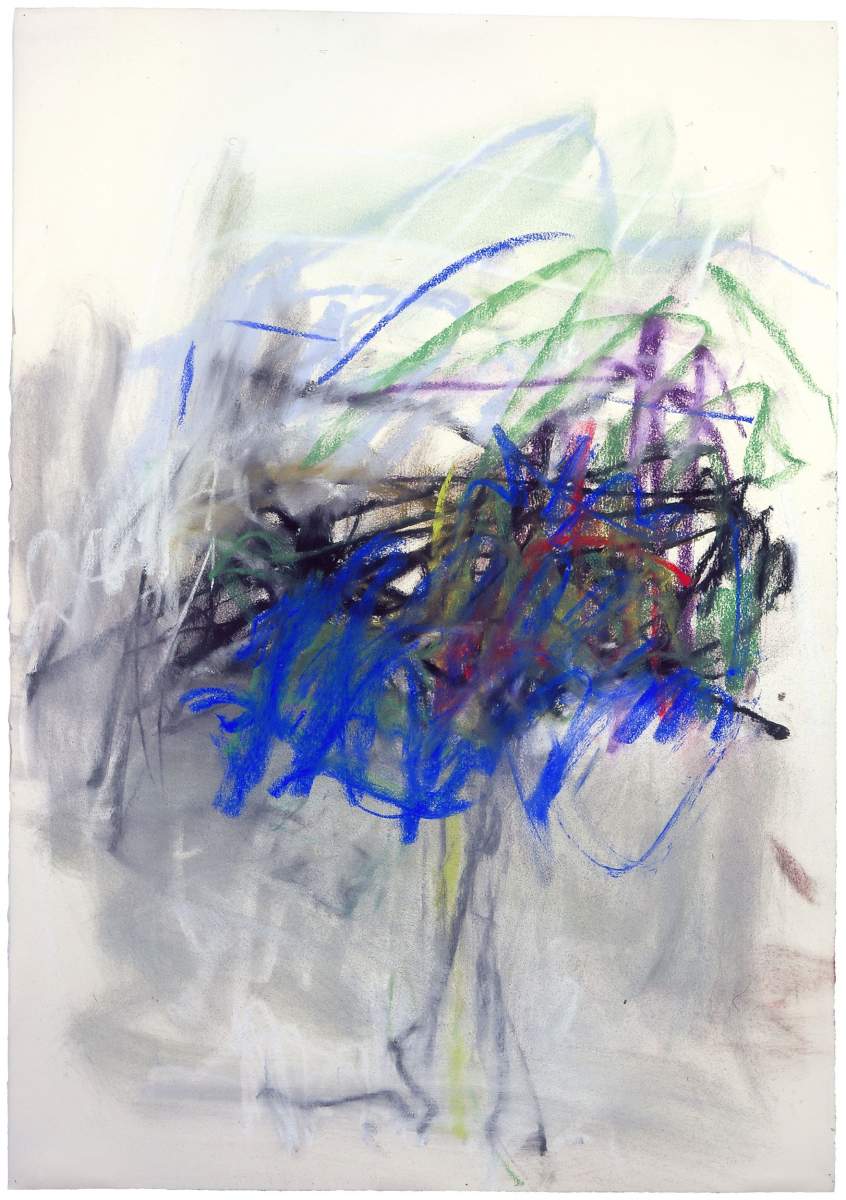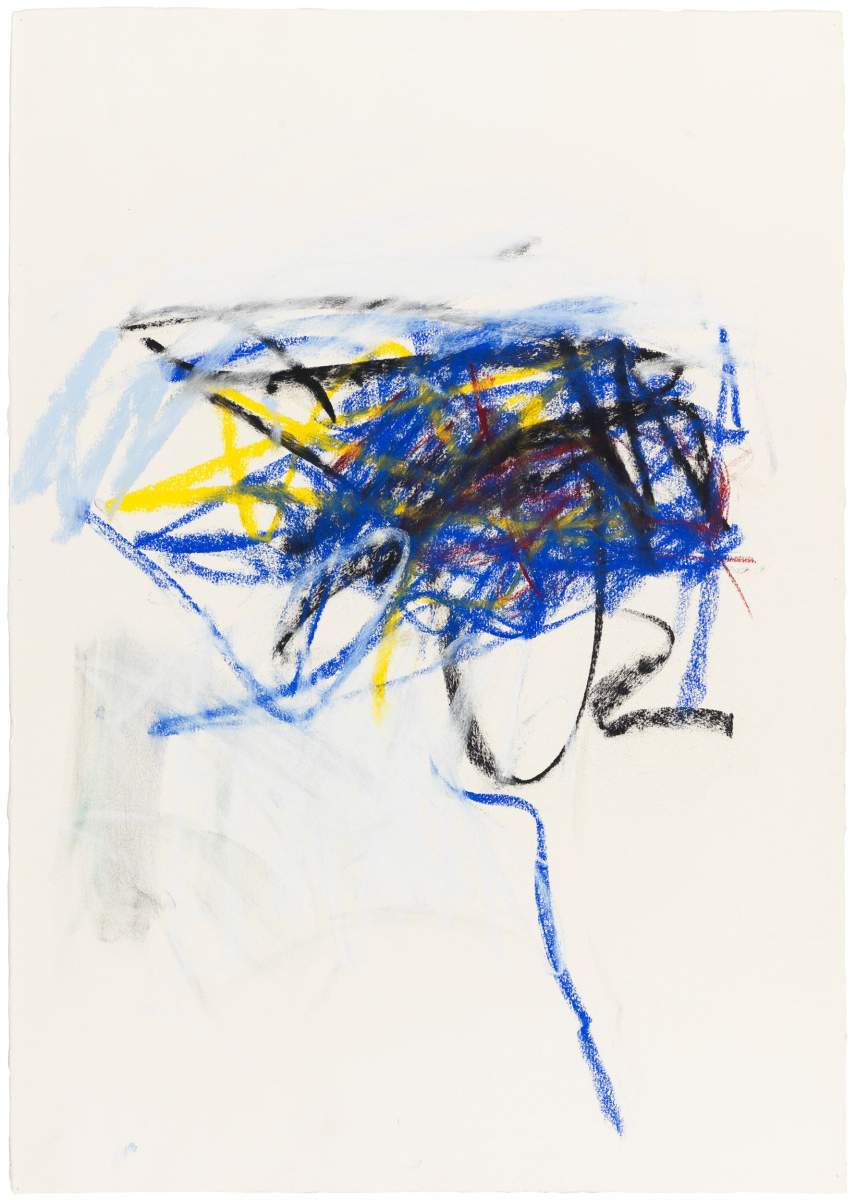
I stopped drinking one night, three years ago, on a date with my then-husband. I ordered a beer after saying that I wouldn’t. He gave me a look and began the talk. He let it unspool: how mean I was when I drank, how mean I was becoming, and how it harmed him.
It wasn’t the first time he had broached the topic, but it was the first time I felt what he was saying. My defense cracked and dropped into a gulf. I recognized, instantly, someone stowing her bottles of wine, telling herself she wasn’t hiding them in a sunken kitchen shelf. I had lost my hiding place. I told him quickly like I was telling him to shut up: I’ll quit. I’ll quit now.
The painter Joan Mitchell quit drinking in the 1980s. Facing cancer, her body crumbling, her doctor told her she would die if she didn’t stop. But Mitchell couldn’t. Instead, she switched from booze to white wine and kept on. In the ’90s, careening closer with death, she made several last pastels on paper. All tenacious high-wire acts.
I can’t look at these works without thinking of the deep drinker who has always been ahead of me. I saw her last October in a pharmacy parking lot, bent over something. I was with my son. We stopped to look. Her quarry was a six-pack of beer, glass necks shattered, foaming over asphalt in gold afternoon sun.
She looked at us. Even in our masks we recognized each other. I could see she wasn’t all there. And I think she saw us as representative of judgmental human culture. She straightened and walked briskly out of our shared presence. Brisk and off-axis toward the hedges in front of the pharmacy.
We could have gone in and told the store, my son said to me later, before she got into a car. But I had latched onto her. When she moved, I moved. I headed back to my car, my son trailing. Something is wrong with this picture. I thought she was bent over an animal or a child, the way she crouched over her lost beers.
“Incompleteness is the baseline state of the addict,” writes Gabor Maté, a physician who worked closely with addicts for years in downtown Vancouver. Mitchell’s last pastels exist in this state. Never resting, they fret. They try and try. In my favorite a mash of blue lines anchor the fraying, frenetic mass above, bewildering itself.
My deep drinker veered toward the hedges, attached and dislocated—where was she going? Away from here forever.
At some point Maté broke from the shame he felt and the silence he kept around his addictive tendencies. He traced their development to a wound he received in early childhood. He was an infant when the Nazis invaded his native Hungary, and, in the story he tells, he would not stop crying. When his mother called the doctor, the doctor told her that all Jewish babies like Gabor were crying; they felt the acute stress and fear in their mothers. Maté linked his addictive tendencies to—and located himself in—a wound story. The context helped him develop a working compassion, a way to see that the destructive patterns he created to soothe himself originated in an imminent feeling of terror that was not his fault.
Mitchell had a wound story, too. She was the second child, the second daughter, and her father had willed her to be a boy. In her biography of Mitchell, Patricia Albers quotes Cindy Nemser from a 1972 interview:
As time went on, [Mitchell’s father] didn’t seem to be able to reconcile himself to Mitchell’s gender since, according to the artist, he was always telling her that she acted like a boy, moved like a boy and so on…It was clear that she had a defensiveness about being a woman and a terrible ambiguity about her identity. She told me that she had been to several psychiatrists over the years as a result of this insecurity.
Not being accepted by a parent is an excruciating wound to bear. A lack where love should be, where one has to exist and hurt and express herself. Did Mitchell forge, like Maté, a working compassion within a wound story? She worked. And the pastels were a part of this work: she put down the brush, seizing color with her hand. Look at this: I was here; I am here. A primary, “I’m in love with this world so fuck it, I’m doing this” activity.
Inside a vexed and private place, where blue and black sign and cosign themselves in urgency, I stopped drinking. My then-husband delivered a gift and a bomb that night. I could have dug in, snarled, and went on drinking. Instead, I broke. In retrospect, I was so ashamed and I hated him and loved him and was living to the side of my life. I sensed that I would lose him if I didn’t cold turkey myself. Fierce counter-will: I stopped. I gave chase; I grabbed sobriety.
In sobriety I found fear. The deep fear of failing, of catching and linking arms with the deep drinkers ahead of me, ones in my family who had drunk themselves into isolation, manic gardening, or death. Thom Gunn writes about the ones he calls his sad captains: “All the past lapping at them like a cloak of chaos.” My sad captains, for the most part, couldn’t find the third space that Mitchell did in her work. Their pain roars inside my own. I couldn’t escape them. I had to befriend them through the deep drinker in me, fierce and lonely in her fear. She had always wanted to be held and to hurl the person who would dare hold her across a room.
I spent my first year without alcohol dazed by its supremacy. I became its fervent local critic. I live in Asheville, North Carolina, “Beer City,” home to 33 breweries and counting, some of which have revitalized the riverside as family-friendly, kite-flying spaces. Have a beer, have three while your kids play by the river. I was furious in these spaces. The fury felt rich and righteous and clear. By my second year in sobriety, I was in pain. I was beginning to sit with something murkier about myself: that the meanness my then-husband had called out and rejected was attached to truth and material I had buried, been burying, and needed to free.
In one of Mitchell’s pastels, a blue line loses everything and is nearly severed as it drops.

I had always been taught to press it all inside, don’t unravel, don’t let them see how you feel. I remember the heat of my head as I sat face down crying at my school desk. I remember disassociating from her, the crying person—doing everything I could not to be her. I remember practicing being quiet, telling myself that this was a Quiet Day, that I had talked too much the day before. I remember in fourth grade making up a story about another girl, a vulnerable girl, like me. I made up a lie about her and then told her on the playground that I hated her. She was crying and asking me why. And I was saying to her, that’s just the way it is now.
“Are you going to start drinking again?” my husband asked soon after I decided I needed to leave our marriage. I have asked my deep drinkers this and all the attendant questions. Am I going to start? Do I really have a problem? They shake their shadowy heads. They nod their shadowy heads. If you are a drinker, your drinking pulses. Your drinking is articulate and needs you to listen.
At a point where I thought I wouldn’t write this essay at all, I reached out to my family’s big deep drinker. She doesn’t drink anymore. She lives with all of us wondering, forever, if she will drink again. I apologized to her. I had never acknowledged that I recognized her struggle. She was the adult who played on the floor with all the kids. I was a kid. She was the fun: fun and drunk. In a family Christmas movie a teddy bear won’t stop making a mechanical sound and she grabs the bear by the neck, opens the front door, tosses it out, slams the door, and looks into the camera and grins.
When she crashed, when she became too visibly out of control for my family of drinkers to ignore, there was no model for the tenderness and outreach she deserved. Not with us. She thanked me when I wrote to her. She offered no continuation of the conversation. But something had opened. Some things open. I mean to leave an opening.
Joan Mitchell put down the brush, picked up the pastel sticks. Pastels are waxy, thick, soft, and hard. They can be mashed. They leave dust and the potential for smudge everywhere. When you press them to paper they are their strong decadent colors right off. Mitchell marked, layered, smudged, and grained them against the paper. She pressed and followed them—her colors, her event—into this vast diminishing space we enter and call home.




